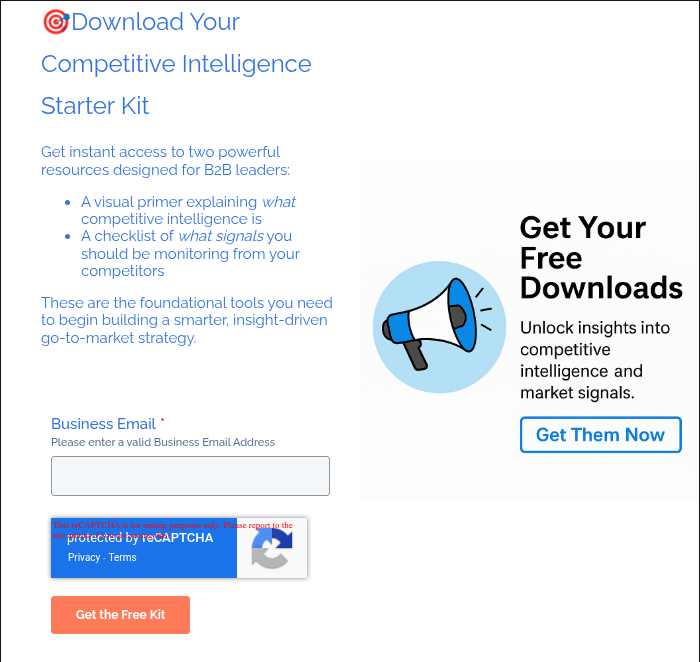In today’s cutthroat business world, knowledge is power. Knowing your competitor's strategies is crucial. That’s where competitive intelligence strategies come into play.
A Particular Set of Skills
As someone with an MBA and experience conducting strategic competitive intelligence analysis for business plans and employers, I and the other competitive intelligence professionals on my team understand the importance of staying ahead of the curve by using competitive intelligence research best practices. But competitive intelligence strategies go beyond simply knowing who your competition is.
Looking to put competitive intelligence into action?
We’ve created a complimentary Competitive Intelligence Starter Kit to help you take the next step. It includes a visual primer to clarify what CI really is—and a detailed checklist of competitive signals you should be watching. Together, these tools will help you and your team start identifying actionable insights immediately.

What is Competitive Intelligence?
Competitive intelligence is about gathering, analyzing, and using information about your competitors and market trends to get strategic benefits from competitive insights. This means you're not just reacting to what your competitors are doing.
You are proactively anticipating their next move by conducting market research in conjunction with gathering comprehensive competitive intelligence. Businesses use the competitive data from this process and subsequent actionable insights to gain a competitive advantage.

Building a Framework for Your Competitive Intelligence Strategies

Competitive Intelligence Methodology
Gathering intel as part of your strategic planning process can feel overwhelming without a solid competitive intelligence framework and a competitive intelligence solution.
Competitive Intelligence Best Practices
Let’s break down how to structure your competitive intelligence strategies for maximum impact:
1. Define Objectives and KPIs
First, clarify what you want to achieve through competitive intelligence strategies. Are you aiming to increase market share, launch a new product, or improve your pricing strategy?
Defining specific, measurable, achievable, relevant, and time-bound (SMART) objectives and Key Performance Indicators (KPIs) is essential. This way, you can track your progress and measure the effectiveness of your competitive intelligence efforts.
2. Identify Your Competitive Landscape
Next, determine your primary, secondary, and even tertiary competitors. Primary competitors are direct rivals offering similar products or services in the same target market.
Secondary competitors target a different market segment or offer a slightly different product. Tertiary competitors might be those indirectly influencing your market or emerging as potential threats.
Pro-Tip: You can use SEMRush to identify competitors that you never even knew existed, let alone that were competing with you. It is an extremely powerful competitive intelligence software solution which greatly amplifies your efforts. It should a key part of your competitive intelligence program.
3. How to Collect Competitive Intelligence
You’ve got your objectives and identified the competition. Now, where do you find the information to fuel your competitive intelligence strategies?
Consider a multi-pronged approach leveraging both online and offline data sources:
- Publicly and Private Sector Available Information: This includes competitor websites, social media, press releases, industry reports, government databases, customer reviews, and forums. You can even glean insights from job postings to understand your competitor's growth areas and talent needs. You can also observe traditional and digital media released by your competitors. After all, they are spending money on it, so they must believe it will give them a competitive edge.
- Sales and Customer Interactions: Your sales team is on the front lines. They interact with customers who are considering your competitors. This offers valuable insights. Sales tactics, win-loss analyses, and feedback from customer-facing teams provide firsthand intelligence on competitor strengths and weaknesses.
- Competitive Intelligence Tools: Various tools automate and streamline data collection and analysis. For example, social listening tools can help monitor competitor mentions, industry trends, and customer sentiment. This is a key aspect of any successful competitive intelligence process. There are Artificial Intelligence tools you can use, such as ChatGPT, Perplexity and many AI systems dedicated solely to the competitive intelligence challenge. But keep in mind that AI talent is in is in high demand but short supply.
- Competitive Intelligence for SEO: When it comes to Competitive Intelligence, SEO, especially what you can glean from those competitors identified by SEMRush, an especially powerful competitive intelligence tool, is worth its weight in 'strategic gold'. A competitive intelligence consulting firm will leverage insights gathered from all of these sources.
4. Choose the Right Competitive Analysis Tools & Techniques
Now that you’re armed with valuable data, it’s time to analyze. Several competitive intelligence frameworks provide structure and guidance. For instance, you can use a SWOT analysis to understand your company’s competitive landscape:
| Strengths: | Internal positive aspects of the competitor. |
|---|---|
| Weaknesses: | Internal limitations or challenges they face. |
| Opportunities: | External factors they could capitalize on. |
| Threats: | External factors that could negatively impact them. |
Remember Porter’s Five Forces to evaluate the overall competitive intensity in your industry. Other models, like the PESTLE analysis (examining Political, Economic, Social, Technological, Legal, and Environmental factors) offer a wider lens to view the market and guide your competitive intelligence strategies. These intelligence examples provide a framework for understanding your competitive landscape.
5. Put It Into Action.
Gathering intel is useless without action. Use your findings to:
- Prepare a competitive intelligence mapping report. This should provide actionable insight not just for your marketing teams, but rather, your entire executive team.
- Shape product development based on competitor offerings and customer feedback.
- Refine your marketing messages to differentiate yourself effectively.
- Empower sales teams to handle objections and showcase your advantages over rivals.
Remember: Ethical Considerations are Key
Always operate within legal and ethical boundaries. Your competitive intelligence strategies should rely on publicly available data. Do not engage in activities that violate privacy or confidentiality. Understanding how to perform competitive intelligence ethically is crucial for long-term success.
Competitive Intelligence Should Inform Your Business Strategy
Now that you have good competitive intelligence available to you, it's time to revisit your business strategy. You should strive to make informed decisions, but always realize that your business strategy rest upon your shoulders. It's what can give you a competitive edge.
Competitive Intelligence vs Business Intelligence
You want your business to be competitive. But it's hard to know what your competition is doing. This is where competitive intelligence comes in. It helps you understand what other companies are up to. What are they doing well? Where could they be better? This information helps you make smarter choices about your own business.

How can you get this information? You can start with something simple. Check out your competitor's websites and social media. What are people saying about them online? Talk to people in your industry. Attend conferences and trade shows. These are just a few ways to learn about your competitors.
After you get some information, think about what it means. Are your competitors releasing new products? Are they targeting a new type of customer? Are they struggling with something you're good at? Once you understand this, you can use it to your advantage.
For example, if you see a competitor is struggling with customer service, you can make sure your business excels in that area. This might attract customers who are unhappy with your competitor. Or, let's say your competitor is developing a new product. This might encourage you to innovate and create something even better.
If you're lucky enough to have an Enterprise Data Warehouse such as SAP BW (SAP Business Warehouse), you use publicly available data sources to 'draw in' information about competitors. If your competitive analysis team also includes data scientist (some competitive intelligence consulting firms will have this capability, or access to it via agency's, such as SAP BW Consulting, Inc. who actually can perform competitor analysis and data science work), they scrape the websites of competitors, turn it into quantitative strategically relevant data and store in your data warehouse for subsequent analysis.
Developing Competitive Marketing Strategies

Smart companies always keep an eye on the competition. They want to know what's working and what's not. This is where competitive intelligence comes in. Think of it as being a detective in the business world. You're always looking for clues to help your company stay ahead. But you don't need to be Sherlock Holmes to do this well.
You can start by looking at your competitors' websites and marketing materials. What products or services do they offer? What do their financial statements reveal. What did they emphasize in their latest earnings reports. What are their strengths and weaknesses? How much do they charge? These are all important questions that you need answers to. This information will help you understand your own company's position in the market.
Social media is another great tool for gathering competitive intelligence. You can use it to see what people are saying about your competitors. What do they like about their products and services? What don't they like? This can reveal a lot about who their target audience is, even if they don't want you to know. This feedback can be very valuable as you make decisions about your own business.
Examine Competitor Product Offerings

Sometimes it's really helpful to know what your competitors are doing. But figuring this out can be tricky! How do you find this information? This is called competitive marketing intelligence. One important thing to do is figure out what products your competitors are selling. This helps you understand what your company is up against.
You might want to look at the prices of their products. Are they cheaper or more expensive than yours? Also, what kinds of features do their products have? Do their products do something that your products don't? Maybe their products are faster or maybe they look nicer. You should also think about their customers. Who are they selling to? Is it the same type of customer as you?
You can use this competitor intelligence product information to make your company better! For example, maybe you can make your product cheaper or add new features. Competitive intelligence works and can really help your company with its financials. And if your company uses SAP software, SAP BW Consulting, Inc. can help you analyze this information!
Conclusion
Effective competitive intelligence strategies provide an edge. This means moving from a reactive stance to proactively shaping your path.
Before You Go — Turn Insight Into Action
You’ve just explored how competitive intelligence can reshape your approach to market strategy. Now, take the next logical step. We’ve assembled a complimentary Competitive Intelligence Starter Kit to help you operationalize what you’ve learned. It includes a visual overview of what CI entails and a structured checklist of competitive signals to monitor—exactly the kind of tools we use with our clients every day.

We are a full-service Hubspot Certified Inbound Marketing and Sales Agency. In addition, we work to integrate your SAP System with Hubspot and Salesforce, where we have a deep delivery capability based on years of experience. Please our book a meeting service to get started.

